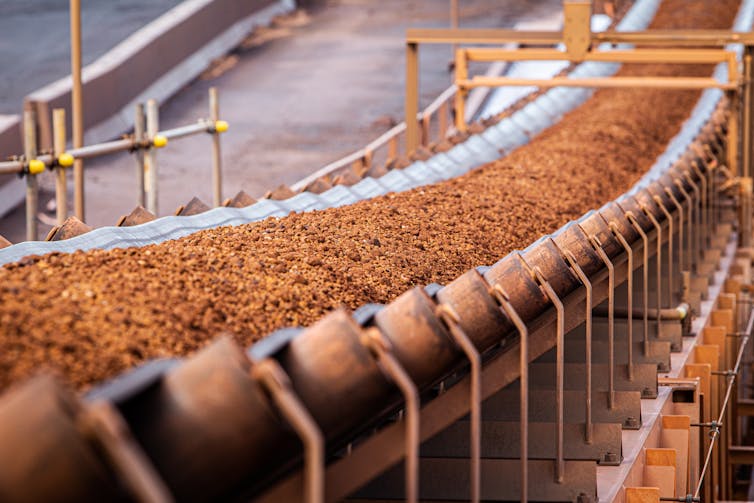This week, the value of the Australian dollar fell to 62 US cents, its lowest level since October 2022.
The acute cause? A revelation by the United States Federal Reserve that it expected interest rates to bottom out at higher-than-expected levels in two years time, due to fewer rate cuts in 2025.
Typically, higher interest rates in the US mean a stronger US dollar. The Australian dollar plummeted despite the fact that the Federal Reserve has recently cut rates three times.
Many – not least those Australians about to travel overseas – will be asking an obvious question: where will the dollar go next?
Unfortunately, short run movements in the exchange rate are nearly impossible to predict. For Australia, however, the bigger picture is what’s happening in China’s economy.
Ongoing economic weakness there has weighed on the Australian dollar, as has speculation about a new trade war, with the looming return of US President Donald Trump. All eyes are on what might happen next.
A proxy for the rest of the world
While the current level of the Australian dollar is a little low, historically, it isn’t highly unusual.
It has visited the 60 US cent range several times over the past couple of decades. In the early 2000s, it even dipped below 50 US cents.
In the short term, movements in the Australian dollar tend to be driven by market expectations of how well the global economy – and in particular China’s economy – is travelling.
This is because our economy is heavily dependent on commodity exports, such as iron ore. Road, rail and buildings are all very iron ore intensive.
When there’s strong growth in China or the rest of the world, commodities prices also go up, pushing up the value of the Australian dollar.
Why? because it creates greater demand for our currency. To buy Australian commodities, you typically first have to convert your own currency into Australian dollars.
On the flip side, pessimism about global – and in particular Chinese – economic growth prospects are likely to see commodity prices fall and weaken the Australian dollar.
This link between the Australian dollar and China’s economy was very evident shortly after the global financial crisis in 2008.
A Chinese infrastructure-led stimulus package led to a booming Chinese economy and demand for commodities, which over following years pushed the Aussie dollar up from the 60 US cents range to the US$1 mark.

Australia’s economy is heavily exposed to the global iron ore price. Aussie Family Living/Shutterstock
China remains unsteady
Knowing this relationship between Chinese growth and the exchange rates helps us to unpack the Australian dollar’s recent weakness.
There’s been serious uncertainty surrounding China’s economy and the extent to which it can continue to grow strongly.
The Chinese government’s plans to stimulate its economy remain tentative. There also seems to be a willingness to allow the commodity-intensive construction sector to remain weak.
The broader outlook for global commodities remains cloudy, and the Australian economy does not have other drivers to support stronger economic growth. Hence, our weak dollar.
What about interest rates?
The other key factor impacting foreign exchange rates is interest rates. Normally, higher interest rates will cause money to flow to an economy and strengthen its exchange rate.
On this basis, the current movements might seem unusual at first glance. The US is already cutting rates, but our own Reserve Bank of Australia is holding steady and not expected to move them for a while yet.
So why did the Australian dollar fall against the US dollar? It’s all about changing expectations.
Markets had already priced in expectations about the pace of US rate cuts over the coming year, which is now expected to be slower.
How markets think interest rates will change in the future matters just as much for cross-border money flows as what they are right now.
However, China’s economic weakness over the past few years has overwhelmed interest rate impacts as far as the Australian dollar is concerned.
Winners and losers
A weaker exchange rate might seem like a bad thing. Australians about to head overseas will be bracing to spend more. On top of this, many of the products we import – such as cars, electronics and fuels – will become more expensive for Australians.
But a weak Australian dollar isn’t a problem for everyone. For some groups, it’s highly beneficial.
Australian exporters may benefit from becoming more internationally competitive because their goods become relatively cheaper. It can also make it cheaper both to visit Australia as a tourist, or pay international student fees to study here.
Overall, the long-term effect of a weak dollar on the Australian economy is often positive, with more jobs and spending in export sectors giving the economy a major boost.



 Glastonbury is as popular than ever, but complaints about the lineup reveal its generational challenge
Glastonbury is as popular than ever, but complaints about the lineup reveal its generational challenge  Britain has almost 1 million young people not in work or education – here’s what evidence shows can change that
Britain has almost 1 million young people not in work or education – here’s what evidence shows can change that  Yes, government influences wages – but not just in the way you might think
Yes, government influences wages – but not just in the way you might think  The Beauty Beneath the Expressway: A Journey from Self to Service
The Beauty Beneath the Expressway: A Journey from Self to Service  Youth are charting new freshwater futures by learning from the water on the water
Youth are charting new freshwater futures by learning from the water on the water  AI is driving down the price of knowledge – universities have to rethink what they offer
AI is driving down the price of knowledge – universities have to rethink what they offer  Evercore Reaffirms Alphabet’s Search Dominance as AI Competition Intensifies
Evercore Reaffirms Alphabet’s Search Dominance as AI Competition Intensifies 
































